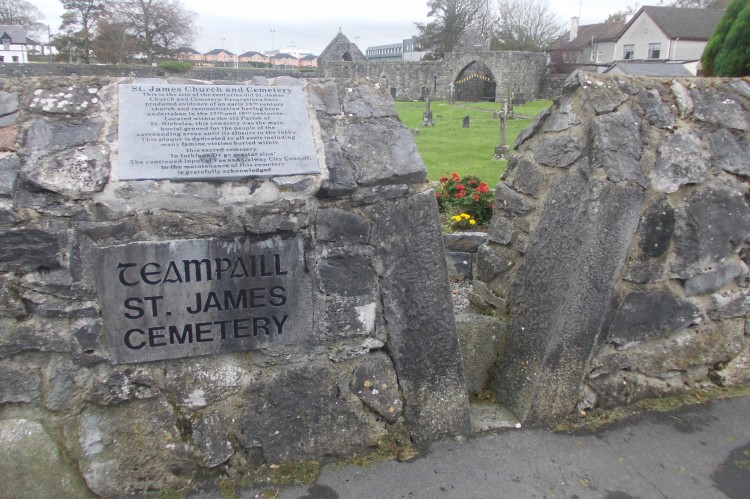 Introduction
Introduction
St James’ Church and cemetery in the eastern Galway suburb of Merview was the subject of a survey and excavation led by Jim Higgins during the 1990s. The excavation and survey programme was funded by FÁS and Galway City Council. Jim published the results of the excavation at the church and the survey of the memorial inscriptions in a book Excavations at St James’ Church and Cemetery which was published by Galway’s Crow’s Rock Press in 1996. While attending the graveyard conference, The Place of Their Resurrection, organised by Jim recently in Galway city the Historic Graves Project discussed the possibility of geolocating the memorial stones in St James’ cemetery and publishing the geolocated photographs on the Historic Graves Site. The following week I undertook a quick geolocated photographic survey at the Graveyard. The memorials were numbered as per Jim’s graveyard plan allowing the information contained within Jim’s wonderful book to be cross referenced with the photographs published on the Historic Graves Site. The book and the online records are another great example of multiplatform publication where traditional and digital methods combine and complement in order to publicise the local heritage resource which is St James’ graveyard.
History
From the excavations and the associated assessment there appears to have been an early 12th/13th century phase of construction which was followed by a late 16th century early 17th century phase of construction.
The church was also rebuilt for some function in the post medieval period. The early history of the church and graveyard is remarkably obscure and the earliest written record comes from the Ordnance Survey Letters for Galway which date to 1838. Jim believes there are three possibilities for the funding and function of the church; it may have been a minor dependency of St Nicholas’ Church in Galway City, it may have may have functioned as a small local parish church or it may have been a chapel funded by a large local landowner and used by the wealthy family and their tenants.
 The Lynch Family
The Lynch Family
A section in the book entitled To Their Memory recounts in great detail histories and stories about the people and families buried in St James’ cemetery. The Lynch family and the Joyce’s were the largest landowners in the area. The church is located on land historically owned by the Lynches of Renmore House who have held land in the area since at least the 16th century when the family owned a castle at Doughiska. This castle is located close to the site of Renmore House the site of which is now a health service facility at Merlin Park. It is likely that the Lynches were responsible for the 16th/17th century additions to the church and were also responsible for the western annex which may even have been constructed as a family mortuary chapel - it certainly contains a 19th century Lynch box tomb.
The Joyce’s
The tomb at the western end of the main church building appears to belong to the Joyce family of Merview House and was one of the first funerary monuments to be built within the church.
Frank Joyce is commemorated by a cross located in the eastern end of the building and records the date of his death as 1890. Frank Joyce was a prominent member of the Galway Blazers and was married to one of the Persse’s a well known
Galway distillery family who made whiskey on Nun’s island in Galway City. Frank’s father Pierce Charles Joyce had a fascinating army career in the Connaught Rangers and was close friends with
T. E. Lawrence (Lawrence of Arabia). The Joyce’s along with Merview House also owned a smaller house which is located to the east of the graveyard boundary wall and now houses the club house of
Galwegians Rugby Football Club.
 Fr James P. Geraghty
Fr James P. Geraghty
The earliest recorded inscription (1864) in the graveyard was recorded on a now conserved box tomb located in the western half of the main church building which was dedicated to Fr James P. Geraghty who was a Parish Priest in Castlegar.
Local newspapers reported that the funeral of Fr Geraghty, who seems to have been highly respected was one of the largest seen in a long time.
Sean Mulvoy
Sean Mulvoy (Seán Ó Maolmhaidh) was a volunteer in Oglaigh na hÉireann who was shot dead by a member of the British Forces at Galway Railway station during an attempted raid on the Galway to Dublin train. Sean Mulvoy was buried in St James’ cemetery in September 1920 and a memorial headstone was unveiled by the Mayor of Galway Michael Higgins in September 1972.
Tom Molineaux
One of the more colourful stories relating to the graveyard involves
Tom ‘The Moor’ Molineaux or Black Tom Molineaux who was a champion boxer who died in Galway early in the 19th century and according to local tradition was buried in a grave marked only by a plain stone at the centre of St James’ cemetery.
Uninscribed Memorial Stones
As Jim Higgins declares in the opening section of To Their Memory, St James’ cemetery ‘contains a cross section of the population, rich and poor and of every class and political persuasion’. Some people were not commemorated at all and some graves were marked only by a rough uninscribed stone. The local historian Norbert Sheeran records that according to local people many who died during the great famine were buried in the cemetery and a stone cross has been erected in the graveyard to the memory of those who died at that time.
Conclusion
St James’ Church and cemetery is a great example of how a comprehensive study of graveyard leads to the uncovering of stories which illuminate the history of the people commemorated within but also illustrate the broader history of the surrounding place. The history of St James’ church and graveyard is intimately associated with the history of Galway City and its people.
 Introduction
Introduction




